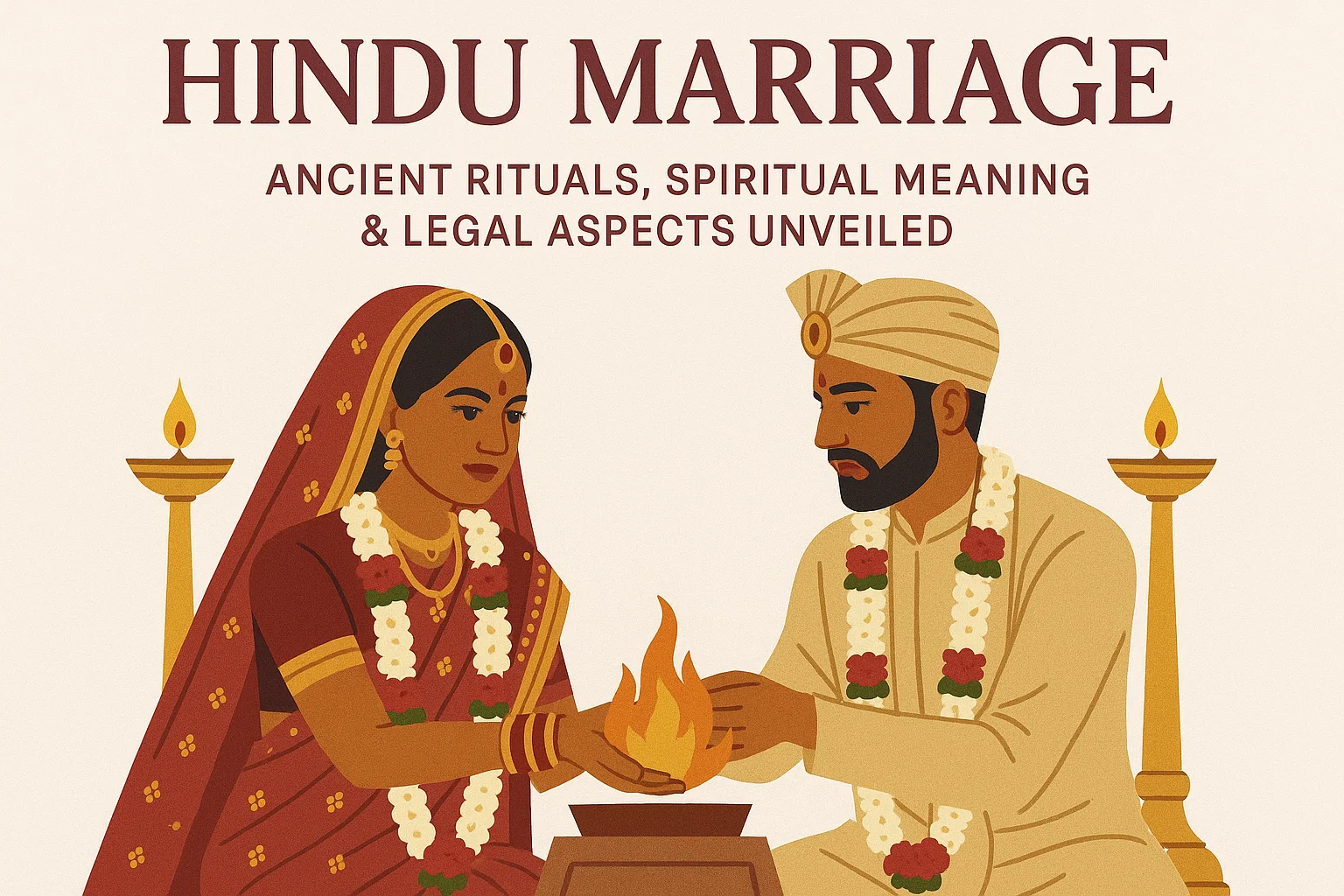Introduction to Hindu Marriage
Hindu marriage is not just a social contract or a legal agreement. It’s a sacred bond that represents a deep spiritual connection between two individuals and their families. Rooted in ancient traditions, a Hindu marriage is designed to uphold dharma (duty), artha (prosperity), kama (pleasure), and ultimately, moksha (liberation). It is regarded as a lifelong commitment, not only between the bride and groom but also between their families, communities, and even deities.
For centuries, marriage has been the central pillar of Hindu society. It ensures the continuation of family lineage, maintains social order, and fulfills religious obligations. Unlike modern Western concepts that emphasize romance, Hindu marriages often revolve around duty, compatibility, and collective harmony.
Spiritual Significance of Hindu Marriage
The spiritual foundation of a Hindu marriage is based on the belief that the union of a man and a woman is a union of two souls on a divine journey. The couple is considered one entity after marriage — spiritually, physically, and emotionally.
Hindu scriptures emphasize that marriage is essential for achieving life’s four aims:
- Dharma – Performing duties and righteous acts as a householder.
- Artha – Economic development and support of the family.
- Kama – Enjoyment of emotional and physical companionship.
- Moksha – Ultimate liberation through fulfillment of duties and detachment.
The ceremony involves invoking deities, particularly Agni (the fire god), as a witness to the union, binding the couple with sacred vows for life and beyond.
Pre-Marriage Traditions
Before any rituals begin, families conduct Kundali Milan (horoscope matching), a key step in Hindu marriages. This step ensures compatibility based on birth charts and planetary alignments. Factors like Guna Milan, Manglik dosha, and Nadi dosha are carefully analyzed.
Once compatibility is established, families discuss dowry expectations (if any), wedding logistics, and mutual expectations. This process is guided not just by religious beliefs but also by caste customs and regional preferences.
Engagement and Pre-Wedding Rituals
The journey toward a Hindu wedding begins with the Sagai or engagement ceremony. This event symbolizes the formal acceptance of the union by both families. Gifts, jewelry, and sweets are exchanged as tokens of joy.
Other important pre-wedding rituals include:
- Mehendi Ceremony – Intricate henna designs are applied to the bride’s hands and feet.
- Haldi Ceremony – A turmeric paste is applied to the couple for purification and blessings.
- Sangeet – A night of music, dance, and celebration involving both families.
These ceremonies foster emotional bonding and generate enthusiasm for the wedding day.
Core Hindu Wedding Rituals
The wedding day is filled with several sacred rituals, each symbolizing spiritual truth and lifelong values:
- Kanyadaan – The bride’s father gives her away to the groom, a powerful gesture of trust.
- Vivah Homa – Sacred fire ceremony where offerings are made to Agni.
- Mangal Pheras – The couple circles the fire seven times, each round representing a different vow.
- Sindoor & Mangalsutra – The groom applies vermillion in the bride’s hair parting and ties the sacred necklace, signifying marital status.
These rituals bind the couple legally, emotionally, and spiritually.
Types of Hindu Marriages
Ancient Hindu texts like Manusmriti outline eight types of marriages, categorized by intent and ritual:
- Brahma Marriage – Considered the most noble, with bride given freely.
- Daiva Marriage – Groom is offered as part of a religious offering.
- Arsha Marriage – Involves token gifts like cows.
- Prajapatya Marriage – Simple ceremony, emphasizing duty over wealth.
- Gandharva Marriage – Based on mutual consent, akin to modern love marriage.
- Asura Marriage – Groom gives wealth in exchange for the bride.
- Rakshasa Marriage – Involves abduction, now outlawed.
- Paisacha Marriage – Forced or immoral union, considered sinful.
Only the first four are accepted in modern Hindu society.
Role of the Vedas in Hindu Marriages
Hindu marriages are deeply rooted in Vedic tradition. Priests chant Vedic mantras during every step of the ceremony, invoking blessings from various deities. The Agni, or sacred fire, plays a central role, representing purity and divine witness.
Astrological Influence on Hindu Marriages
Astrology plays a massive role in Hindu weddings. A suitable muhurat or auspicious time is chosen for every event, based on the lunar calendar and planetary positions. Many couples also consult astrologers for naming future children and family planning.
Clothing and Symbolism
Hindu weddings are rich in visual symbolism, and the attire worn by the bride and groom plays a vital role in conveying tradition and values.
- Bride’s Attire: The bride typically wears a richly embroidered saree or lehenga in red, maroon, or gold—colors symbolizing prosperity, fertility, and auspiciousness. Her look is completed with intricate jewelry, bangles, and flowers.
- Groom’s Attire: The groom often dons a sherwani or dhoti-kurta, paired with a turban (safa) and sometimes a sword, representing protection and honor.
Each accessory, from the bride’s mangalsutra (sacred necklace) to the toe rings (bichiya), has symbolic meaning tied to marital status and commitment.
Role of Family and Community
In Hindu culture, marriage is not just the union of two individuals but the merging of two families. The active involvement of parents, siblings, extended family, and even community members is a hallmark of Hindu weddings.
- Arranged Marriages: Still prevalent in many parts of India, arranged marriages rely heavily on family networks, astrology, and social compatibility.
- Parental Blessings: Elders bless the couple during and after the rituals, ensuring the continuation of traditions and generational wisdom.
This collective participation strengthens social bonds and reinforces the importance of community support.
Legal Recognition of Hindu Marriages
Hindu marriages are not only sacred but also legally recognized under the Hindu Marriage Act, 1955 in India. This act applies to Hindus, Buddhists, Jains, and Sikhs.
Key legal aspects include:
- Monogamy: A man or woman can have only one spouse at a time.
- Minimum Age: 21 for men and 18 for women.
- Registration: Though not mandatory, registering the marriage provides legal proof and is encouraged.
The act also outlines provisions for annulment, judicial separation, and divorce.
Challenges Faced in Modern Hindu Marriages
While Hindu marriages are steeped in tradition, they are also evolving in response to modern challenges:
- Inter-caste & Interfaith Marriages: These unions face resistance from conservative families but are becoming more accepted in urban areas.
- Dowry System: Despite being illegal, dowry-related expectations still persist in some regions, leading to social and legal concerns.
- Urban-Rural Divide: Lifestyle differences influence expectations, compatibility, and even the scale of ceremonies.
Modern couples often seek to balance tradition with individual freedom, equality, and practicality.
Hindu Marriage in the Global Context
In today’s globalized world, Hindu marriages are celebrated across continents by the diaspora. While many customs are preserved, they often blend with the host country’s culture.
- Destination Weddings: Increasingly popular among Indian-origin families abroad.
- Cross-Cultural Unions: Hindu weddings now often include Western elements like wedding vows or reception speeches.
- Legal Complexities: Overseas Hindu marriages may require additional legal formalities depending on the country.
This fusion of traditions enhances cultural appreciation and global understanding.
Divorce in Hindu Marriage
Historically, divorce was taboo in Hindu society. However, with legal reforms and changing social norms, it is increasingly accepted, especially in urban areas.
- Legal Grounds: Under the Hindu Marriage Act, couples can file for divorce on grounds such as cruelty, desertion, or mutual consent.
- Social Stigma: While still present, stigma around divorce is slowly fading.
- Counseling: Many couples undergo marital counseling before deciding to separate.
Despite the option of divorce, the sanctity of marriage remains deeply respected in Hindu culture.
Comparison with Other Religious Marriages
A Hindu marriage differs significantly from other religious marriages in both ritualistic and legal aspects:
| Religion | Ceremony Highlights | Legal Framework |
| Hindu | Sacred fire, Vedic chants, seven vows | Hindu Marriage Act |
| Muslim | Nikah, Mehr (dower), Qazi-led prayer | Muslim Personal Law |
| Christian | Church wedding, exchange of rings, priest blessings | Christian Marriage Act |
| Sikh | Anand Karaj, Guru Granth Sahib recitation | Sikh Rehat Maryada |
These distinctions highlight the spiritual diversity and cultural richness of India.
Frequently Asked Questions about Hindu Marriage
1. What is the purpose of Hindu marriage?
The purpose is to fulfill spiritual, social, and familial responsibilities and to seek life’s four goals: Dharma, Artha, Kama, and Moksha.
2. Is horoscope matching compulsory in Hindu marriage?
While not legally required, horoscope matching is a common cultural practice to ensure compatibility.
3. What are Mangal Pheras?
They are seven sacred rounds taken around the fire, each symbolizing a unique marital vow and blessing.
4. Can a Hindu marriage be registered under Indian law?
Yes. Couples can register under the Hindu Marriage Act or Special Marriage Act for legal recognition.
5. Are love marriages allowed in Hinduism?
Yes. While traditionally arranged, Hinduism does not forbid love marriages, especially when mutual respect and consent are present.
6. What is the significance of Sindoor and Mangalsutra?
Sindoor (vermilion) and Mangalsutra (sacred necklace) are symbols of a married woman’s status and her husband’s long life.
Conclusion
Hindu marriage is a profound blend of sacred rituals, spiritual values, and evolving customs. It transcends being a mere ceremony—it’s a lifelong partnership rooted in mutual respect, love, and dharma. While the traditions may adapt over time, the essence of a Hindu marriage remains eternal: a union of souls, blessed by gods, and nurtured by families.

